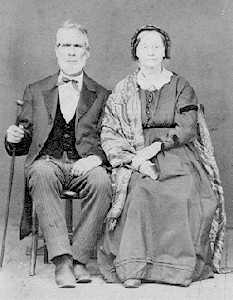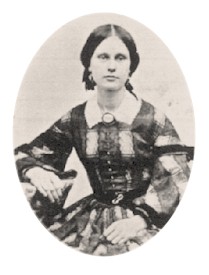When a gentleman chooses his wardrobe he should do
so according to the WHERE YOU WERE approach. Wool was perhaps used more
often in the North whereas cotton, linen, or a cotton/wool blend was
more popular in the South. Wool is appropriate for a Southern
impression if preferred, but the lighter fabrics are appropriate and
cooler. Again, 100% cotton, linen, and wool are recommended with the
avoidance of synthetics which do not "breath". NO zippers, elastic, or
velcro. NO cowboy pants, coats, shirts, hats, or boots. We recommend
Past Patterns or Homespun Patterns. See Ladies guidelines for web site
offering Homespun Patterns.
DRAWERS: Cotton, drawstrings at the waist and at
the ankles if preferred. For cold weather events drawers might be made
of natural colored flannel similar to flannel used in the period.
COATS: A frockcoat or sack coat may be worn
depending on personal preference. A frockcoat may be double or single
breasted, solid or tweed fabric. Appropriate colors include black,
brown, gray, or dark blue. Simple patterns are acceptable or for a
dressy look a vest might be of more elaborate fabric. A frockcoat might
have a velvet collar. The lining could be of muslin, or polished
cotton. The skirt is long and square with a split up the back. A sack
coat might have more variance as to pattern of fabric. Length was
generally mid-thigh. A sack coat should fit loosely and has no obvious
waist seam. Coats had shoulder seams dropped from the natural shoulder
line.
PANTS: Pants have a button-fly closure (no
zipper) and the waistband is split in back held together with ties.
Legs aren't creased and have no cuff. Pants are worn with braces
(suspenders) which might be white or patterned. The pants fabric might
match or contrast to that of the coat. Remember in choosing fabrics
that black was often used for formal occasions and the suit worn with
white gloves. Period pants generally are higher waisted and the band is
l - l l/2" wide. Legs are straight. Period belts were of a distinctive
design, and were not worn through belt loops. If you choose a belt over
braces please make sure it is the correct type, and worn correctly.
VESTS: Vests should be worn as part of a
gentleman's dress as Victorians generally considered it inappropriate to
venture outdoors without a vest and/or coat. Fabric might be wool,
cotton, or linen and might match either the pants or the coat. It is
generally thought that two of the three pieces should match, however, in
the blockaded South this was not always possible. Acceptable fabric for
a vest might also include silk, brocade, tweed, and might be plaid or
stripes. Vests are usually lined in 100% muslin or polished cotton, and
the vest back might be black, brown, a print, or white polished cotton
or muslin. Shawl collars are appropriate for vests if preferred. Vests
should be square across the bottom and not come down to points in the
front. They may buckle or tie in back.
SHIRTS: Shirts might be white or any number of
prints with the homespun look being extremely popular for a Southern
impression. Colors would be similar to those worn by ladies and it
would be very appropriate for a lady's dress to match that of a man's
shirt since homespun was used for many purposes. Wooden or bone buttons
would be appropriate. Shirts should have dropped shoulder seams.
ACCESSORIES: A tie or cravat might be worn for a
dressier look. A silk hand tied bow tie is acceptable. A gentleman's
handkerchief would be larger than modern ones and measure approximately
l8 inches square. Cotton would be the fabric of choice and it might be
white or print. Gloves might be leather or white cotton. A gentleman
should obtain a repro. period watch at some point. No wristwatches.
FOOTWEAR: Brogans are the most common choice and
easiest to find. Toes should be square and the shoe should not taper to
the toes. Colors were usually black or brown, but sometimes gray was
worn. For a dressier look a gentleman might consider reproduction
ankle-high boot with elastic in the side or knee high riding boots. No
pointed toe shoes or boots please. Please refer to the advanced ladies'
guidelines for ordering information from Lincoln Log Cabins for brogans
and boots, or consider Missouri Boot & Shoe or Robert Land.
HATS: May vary according to personal preference
from a cap to a broad brim hat, bowler, derby, stovepipe, or top hat. A
straw hat would be appropriate - Amish style - no modern straw hats.
Hats may vary in color with brown and black perhaps being the most
popular.
EVENING WEAR: A frockcoat of dark color would be
a good choice with a dressy vest. The shirt might be white with
ruffles. Black would be the preferred color for pants, if possible.
The tie might be white as would the gloves. A proper Victorian
gentleman would not offer a lady his sweaty palm when asking for a
dance.
BUTTONS: Wood, horn, bone, china, or perhaps
pewter would be acceptable. Persimmon seeds on a homespun shirt would
be proper for a Southern impression. Button holes must be
hand-stitched. The technique for making machine button holes had not
been created in the mid-19th century.
SOCKS: Please consult your Mentor for
recommendations.
ACCOUTREMENTS: A gentleman will want proper
tools, books, pens, or other items necessary to his impression. For
assistance please consult your Mentor.
Male civilians are a welcome part of HLHG. Members will be happy to
discuss potential impressions and offer assistance on perfecting
something that appeals to you.


